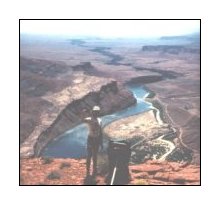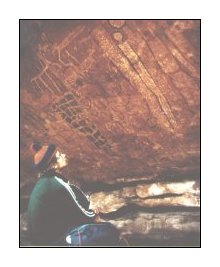|
Robert |
|---|
His name is legendary among a generation of Grand Canyon explorers, hikers, and river runners. During his brief tenure in the American West he touched the lives of such notable men as George and Allen Steck, J. H. Butchart, Don Mattox, Kenton Grua, Kim Crumbo, and Ken Phillips. The Grand Canyon river runners of the early 1980's knew him simply as Robert, the only man to walk alongside the Green and Colorado Rivers in one continuous trek . . . down on river-right from near Green River, Utah, to Lake Mead. Then reversing his direction, he walked back upstream on river-left to Moab, Utah. John Shunny, a close friend of Robert's, dropped him off at the head of Horse Canyon and described the start of his adventure:
| "His epic journey-along the Colorado, north side, from the upper reaches of Lake Powell through the Grand Canyon to Lake Mead and return, south side-began to take shape in the early 80's. Caching trips alone became significant expeditions, with more than twenty required on both north and south sides. Acquiring the necessary permits from skeptical government agencies took infinite pains and patience, the latter not one of Robert's noticeable qualities (as Robert progressed in his journey, the same government people who had, with justification, been skeptical, became ardent supporters of the enterprise.)" |

It was through John Shunny that Robert met the Steck family. George was planning a long hike of his own, from Lees Ferry to Lake Mead. Robert joined the Steck party at Lees Ferry and accompanied them on to the Grand Wash Cliffs. While with the Stecks, Robert became an adopted son and valuable complement to the group. This section; however, would take its toll on Robert's body. The intestinal problems that would plague him later first appeared when the group was coming into the Nankoweap area from Marble Canyon. Thanks to a helpful river runner, Liz Hymans, Robert received the medication needed to get back into hiking condition. Then---many footsteps later---Robert lost both handholds and fell during his descent from the top of Elaine Castle and cracked his pelvis bone. He was alone at the time, his companions busy with the long Tonto walk around the front of Powell Plateau. He somehow managed to get to Teddy's Cabin with his pack, located just below Muav Saddle, some twelve hiking miles away from Elaine Castle. This arduous task took him four days.
Robert convalesced in the cabin for seven days, refusing evacuation by the Park Service Rangers. He was going to finish his hike! George; meanwhile, had become alarmed when Robert didn't rendezvous with the rest of the group in the Tapeats/Thunder River Gorge as planned. Bad news travels fast in the Grand Canyon and George soon learned of Robert's fall and subsequent decision to carry on with the trek. Incredibly, he caught up and continued with the Steck party on to Lake Mead.
After stashing the last of the required southside caches, Robert said goodbye to George and Helen as he started back upriver. In his upriver log, he describes the parting with the Stecks:
| "Lake Mead, March 20, 1983-It was a beautiful morning, not a cloud in the sky. I could not have asked for a better day. . .all I wanted was a sunny start since it would reflect on the entire trip. The air felt fresh and cool-almost a little chilly. My thermometer said 40 degrees. Helen, dressed for a polar expedition, jumped immediately (from the sleeping bag) into the car. George followed, started the car and shortly after turned on the heater to full blast while Helen served us coffee. At almost 7:00 a.m. the sun climbed up from behind the skyline of the Grand Wash Cliffs, melting the morning chill with its warming rays." |
Eighteen days later Robert met two people who were even more adventurous than he. While walking above but adjacent to the river, he noticed the canoeists. In his hiking log he has this to tell us about the historic meeting:
| "Ravine at Mile 202, April 7, 1983-Windy morning again blowing right through the sac. . .At mile 200.5 an outcrop of limestone sheers off into the water, but it was easy to bypass by climbing up about 60 feet. As I had reached the top I took my first morning break, when suddenly I noticed 2 canoes coming up the river. It was only yesterday from the boat party that I had heard about some adventurers trying to paddle upstream. Might be inspiring to have a few words with those guys. I yelled until they noticed me and asked them to come on shore. Verlen Kruger and Steve Landick, two pioneers from Michigan, not just attempted to canoe up the Grand Canyon, but included this section as part of a 3 year-28,000 mile canoe challenge. And I thought I was nuts." |
Kruger and Landick would complete their unbelievable loop from the headwaters of the Missouri River via the Lewis and Clark route to the Pacific Northwest, down the coast of the Western United States and around the Baja to the mouth of the Colorado River at the Sea of Cortez. After they journeyed up the river and met with Robert, the two men, father and son-in-law, both paddled home to divorced wives.
Robert, too, would finish his epic hike on schedule and in good condition. One wonders---even those of us with wanderlust---what would drive men to complete such enormous undertakings. In Robert's case, a clue may exist in his teenage lifestyle. Born in Weidenberg, (West) Germany in 1956, Robert was a bright student in his early childhood. No one knew about dyslexia in those days and his condition went untreated. Robert's grades fell from A's to D's by the time he was 12 years old. Running away from his father's wrath, he made it to Paris, and as he later related to George Steck, "lived on the streets, drinking from the gutter and eating out of garbage cans." No wonder he had a sensitive gut. He finally became so sick that his father was summoned to take him home. His father made him promise that he wouldn't run away from home again until he was at least 18 years old. The father-son relationship did not improve, and Robert left for America not long after his 18th Birthday.
It didn't take Robert long to find the Desert Southwest. The Shunny family was on their way to climb atop Cabezon Peak, New Mexico, when they met Robert. Along a hot and dusty dirt road in May of 1976, John stopped near Cabezon to talk to a lone backpacker, "Where are you heading?", asked John, "To La Madera", replied Robert. It seems, John wrote later, "that he was collecting visits to New Mexico ghost towns, and La Madera-some 50 miles distant, was next on the list." The Shunnys would offer Robert the hospitality of their home in Albuquerque, and eventually introduce him to Don Mattox and George Steck. John describes the meeting of the three hikers:
| "I introduced him to my friends, George Steck and Don Mattox, both of them veteran canyon runners who do it the hard way. . .on foot. At first, they were put off by this young man, a recent arrival who talked brashly, even arrogantly, of long forays into the Canyon. They knew that the Canyon record was replete with stories of half-baked expeditions, where an overestimate of resources and an underestimate of the challenge produced disaster." But Robert redeemed himself on backpacks in the Canyon with George and Don. It was clear that he was competent down there among. . .the carnivorous limestone. About this time when someone would ask me what our house guest did, I'd say that Robert was a professional backpacker who took work breaks. That is, he worked as a carpenter with my son until money was sufficient for his next trip." |
Robert was a good carpenter and could have been successful in Albuquerque in those days, but the call of the Canyon was strong and Robert couldn't resist the challenge of his epic hike. His journey began at the head of Horse Canyon on July 3, 1982, and ended in Moab, Utah, on August 30, 1983. During this period, except for a short time between the downstream and upstream sections, he was on the trails and covering the routes of Grand and Glen Canyons. The hardships and travails that Robert endured are expertly set down with his hiking times and route descriptions in his handwritten daily logs with accompanying maps. The upstream log describes the difficulties he had and the disappointment he felt when George Steck, who joined him at the mouth of the Little Colorado, had to leave the Canyon at Eminence Break with a bad back. Other than that small section, Robert hiked the upstream side alone.
Robert Benson Eschka-he took the name Benson from a gravestone in Minnesota East to use while in this country. Eschka is his German surname. Robert didn't seek fame for his exploits, his canyoneering was done for pure joy. He was at home in the Canyons of the American West, and perhaps should never have come back to Albuquerque. He took his own life here, only a few blocks from where I live, on March 14, 1984. He was 28 years old.
As time has passed and I have learned more about Robert, I am increasingly impressed with what he could have accomplished had he lived longer. When George scattered Robert's ashes into the river gorge, I was along on the hike and paid scant attention to the ceremony. At the time I knew little about his life, just what George had mentioned in casual conversation. After reading his journels and maps, it is obvious that he was one of the best at what he loved- Grand Canyoneering!

From The Grand Canyon Pioneers Society Newsletter, Winter 2000
******
Used by permission of the Grand Canyon Pioneers Society.
|
|
|---|
|
|---|